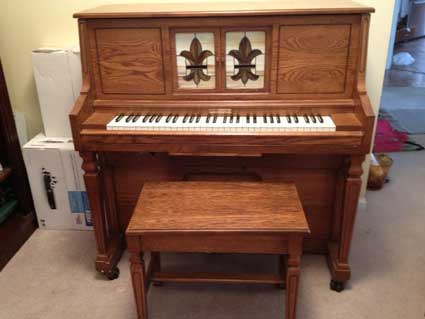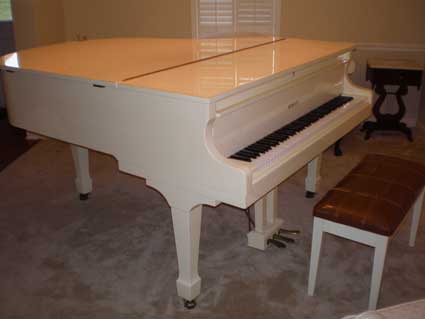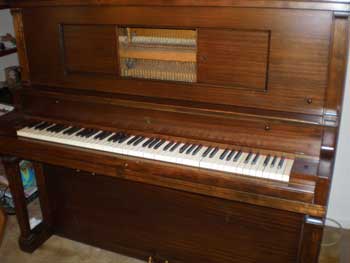

|
Aeolian Player For SaleAeolian Player For Sale - $200 - Oakton. Va.
Gail @ 703-620-5856  _____________________________________________________________ Aeolian 5' 9" White Grand Piano For Sale in Cordova, Tn
$2500 or Best Offer. Call 901-827-3609 SOLD  Aeolian Upright Piano For Sale - Made in 1923.
 This used to be a player piano. The panels that are open in front of the action will close. Some action work and tuning were last done in summer 2011. Located in the Southaven and Horn Lake Ms. area - $200 - Call Roy at 662-342-1413 This used to be a player piano. The panels that are open in front of the action will close. Some action work and tuning were last done in summer 2011. Located in the Southaven and Horn Lake Ms. area - $200 - Call Roy at 662-342-1413History of The Aeolian Piano Company
The Aeolian Piano Co. was started in the late 1800's. It changed hands 5 or 6 times in it's long interesting history. The Tremaine family first owned it. Now the Gibson Guitar company owns the name.
William Tremaine established the company in 1887 as the Aeolian Organ & Music Co.. His son Harry took over in 1898 and changed the name to The Aeolian Company. Harry turned the co. into a piano industry giant. Over the next 35 or 40 years he acquired a huge number of piano names or brands. The Amercian Piano Co. merged with Aeolian in 1932. This brought even more piano names under the control of Aeolian. There were factories in New York, Paris, Berlin, London, Melbourne and Sydney. They employed well over 5000 people and had capital of over $15,000,000. This was a huge amount for a piano factory to control in the early 1900's. The ability to hold a large amount capital is one reason Aeolian, Baldwin, Steinway, Kimball, Wurlitzer and a few other US piano plants survived the Great Depression of the 1930's. The Aeolian brand itself was never used on their instruments in the earlier years. But it was used in later years on foreign made grands and uprights. In the late 1800's William Tremaine was a very successful home organ maker, selling chamber organs to the wealthy. They also manufactured a huge number of player pianos and supplied player actions to many other companies. The player piano business was tremendous before the Great Depression. Aeolian continued to build player pianos until 1982. Early players had the Aeolain Company name cast on the plate inside. But there were many different brand names placed on the front of the pianos. One of them was Pianola. Entertainer was another name used. In 1959 Winter & Co bought Aeolian. The Winter Co. also made player pianos. In the 1960's Aeolian made as many as 50,000 instruments some years. That's about 200 a day. Only the Kimball company may have produced more than that in one year. And Asian piano makers have surpassed that number in annual production. In 1983 Aeolian was sold to a former president of Steinway. This last plant was located in Memphis,TN. The Memphis factory, which had actually built pianos since 1951( as Ivers & Pond ), closed in 1985. The rising costs of the industry, employee problems and quickly rising Asian competition were about to end the long continuous run of profitable piano making that Aeolian had enjoyed for so many years. But they were not the only 100+ year old Americian piano maker that collasped in the 1980's and 90's. In 1985 Wurlitzer acquired the Aeolian name. Baldwin later acquired many of the Aeolian piano names in the 1990's after Wurlitzer closed. Baldwin went out of business in 2001 and Gibson Guitars bought Baldwin. Gibson now owns the name plus many others. They may not be using the Aeolian name on current production. Search for more pianos for sale in Memphis Tn, and other cities. Aeolian Player Piano History
The Aeolian player piano was probably the largest selling player ever. It flourished in the early 1900's during the first heyday of the American piano industry. Radio, the great depression of 1929 and World War II nearly crushed the industry. Although pianos were made and sold during the 1930's, sales dropped considerably and by the late 30's the player era was just about over.
After WWII the piano business as a whole slowly begin to recover and entered into what I call it's second heyday. Although this second hey day was never quite as big as the first one in the early 20th century. The Aeolian Piano Company for it's entire history depended on higher volume or mass production. And by the early to mid 1980's high volume sales were no longer a reality. One reason was the competition from Yamaha, Kawai, Young Chang and other Asian piano manufacturers who were starting to produce electronic digital pianos and digital player pianos(the ones with an electronic unit that used a disk instead of a mechanical one that used a roll), along with nonplayer instruments. They basically captured the US market from all American companies. Baldwin included. Plus the old roll style player piano was apparantly no longer as popular. So by the mid to late 80's this 2nd hayday was just about over. At least for the US plants. Currently though the QRS player roll co. does make a traditional Story and Clark player piano. Now days it is refreshing to see some enthusiasts such as piano techs and a few individuals rebuild those old instruments. They find them in garage sales, antique stores and estate sales. The Aeolian Co. first offered the Pianola in 1897 and it is believed that Tremaine (owner of the plant at that time) was the main force in developing the player piano industry. An aggressive advertising campaign was launched and the Pianola sold for around $250. Now days a completly rebuilt and refinished one might sell for as much as $15,000 or more. They also introduced the Metrostyle in 1901 and the Themodist in 1904 which was able to bring out the melody. And in 1913 the Duo-Art mechanism, which is a reproducing player piano, was introduced and was used in Weber, Steck, Stroud, Wheelock, Steinway and later Winter. The reproducer was a high point for the industry. It meant that now a roll could reproduce a piece of music exactly as the pianist played it with expression. Aeolian's sales in 1925 were nearly 200,000 units. But along with the 1929 depression, radio plus the talking movies and the better sounding phonographs this all nearly ruined the entire piano industry, not just the player business. Over half of all pianos made for about 15 years prior to 1929 had been players. In reality many smaller companies had gone broke by the mid 1920's. Pianos of all types could not compete against the new electronic devices of that time. Radio and record players. Not to mention the popularity of movies. But look at today. Not even electronic keyboards have yet killed The Piano. "The King of Instruments". Long Live The King! After all, the Aeolian Player Piano really was just a deversion. There will always be great human piano players. Also See: Piano Facts Yamaha Baby Grand for Sale Wurlitzer Piano for Sale Kawai KG-2C Grand Piano |
Solo piano music for weddings and parties in the Memphis TN area. Jazz combo also available. Call: 901-827-3609
|
|||||||||||||||||||||||||||||||||||||||||||||
|
info@thepianotickler.com |
|||||||||||||||||||||||||||||||||||||||||||||||